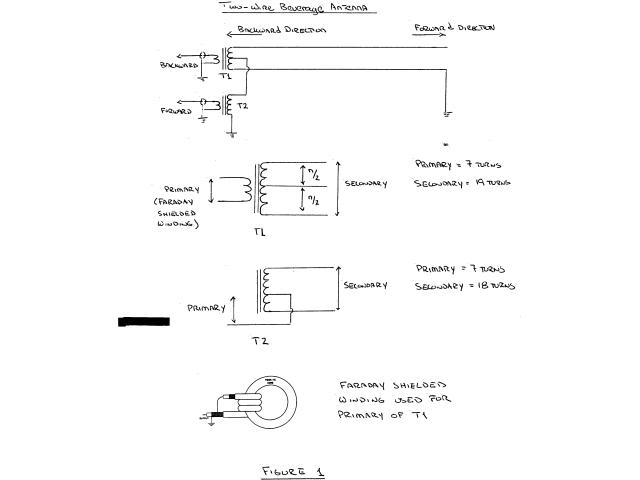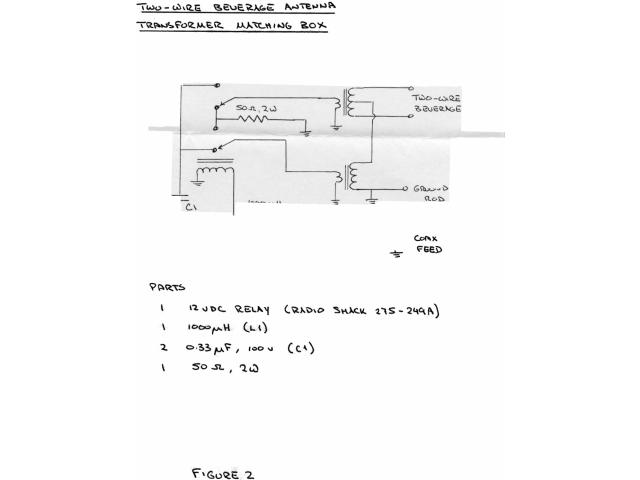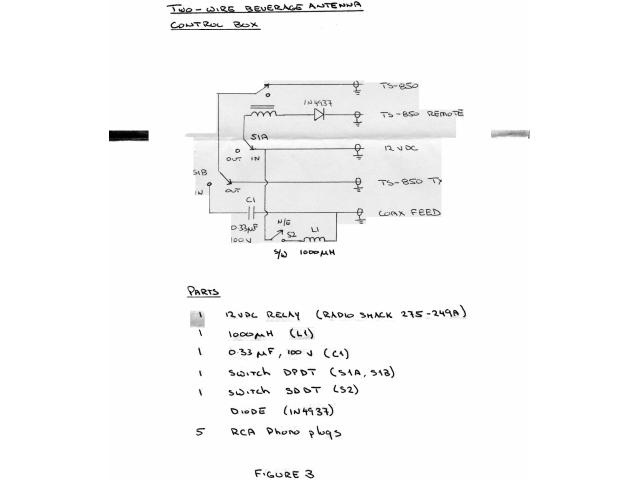by Jeff Parker, KA1GJ
I recently erected a simple two-wire Beverage antenna and, during a recent on-the-air meeting, was asked to write it up for the Scuttlebutt. The design of this antenna is published in the two excellent books listed below as references 1 and 2. The two-wire Beverage is fed from one end but can be switched to receive either from the forward or the backward direction. This system is really very simple and, with help from W1FV, I erected a very nice antenna.
My two-wire Beverage consists of two 14 AWG wires run parallel to each other for 450 feet in a NE/SW direction behind my QTH. The wires are approximately 8 feet off the ground and spaced 12 inches apart. I used trees as the supports, one wire on each side. The 450 foot run is quite straight. The antenna is fed at the SW end through two transformers to match to a single 50 ohm cable approximately 60 feet long. One wire at the NE end is grounded and the other is open. I built up a box (outside) containing the matching transformers and a relay to switch directions and a control box (inside) for 1) selecting either the transmitting antenna or the Beverage antenna when receiving, 2) selecting the Beverage direction and 3) disconnecting the receive antenna input when transmitting.
Shown below in Figure 1 is a schematic for the antenna and the matching network.

In the backward direction, the two-wires work as an open-wire feeder in push-pull mode. Transformer T1 transforms the RF from the open-wire feeder to the unbalanced 50 ohm coax. In the forward direction, the two-wires act as a transmission line made of parallel conductors. Transformer T2 transforms the RF from the two-wire transmission line to the unbalanced 50 ohm coax. I used Amidon FT-82-75 cores which I purchased directly from Amidon Associates. At the time of the writing, cores cost $1.20 plus shipping. Following reference 1, 7 turns were used for the primary windings of both T1 and T2. As per reference 2, the primary of T1 was wound as a Faraday shielded winding (see below). I found that 19 turns were required as a secondary for T1. This differs from both references but yielded the best match. W1FV has a very similar two-wire beverage and also found less winding were required for the secondary of T1. I found 18 turns were required as a secondary for T2.
The two transformers were assembled into a box as shown in Figure 2.

12 DC is supplied from the shack over the 50 ohm feed line and is used the toggle the relay. In the 0 VDC state, the output from T1 is fed through a 2 watt 50 ohm resistor to ground and the output from T2 is coupled to the feed line. This causes the antenna to receive in the NE direction. When the relay is powered, T1 is coupled the feed line and T2 is terminated causing the antenna to receive in the SW direction. It is important that transformer not feeding the 50 ohm coax be terminated in a 50 ohm load. In addition, I found that a good ground was necessary at both the NE and SW ends to achieve the best match.
The antenna direction is selected form the shack with a control box shown in Figure 3.

The control box serves a number of functions. First, either the transmit antenna or the Beverage antenna can be selected for receive. Second, the Beverage direction is selected by applying 12 VDC to the 50 coax feed line which powers the relay in the matching box. Power is available in the shack and is placed on the feed line through inductor L1. The RF is coupled to the receiver through C1. Third, the receive antenna input is disconnected during transmit. For the Kenwood TS-850, pins 2 and 4 on the REMOTE connector are used to key the relay on transmit. This line is wired in parallel with the key line for my Ameritron linear amplifier.
I suggest using mini-coax where ever possible when wiring either box to reduce the chance of stray pick-up. The noise level of the antenna is considerable lower the either my vertical or my dipole and shows approximately 4 s-units of front-to-back performance. I am looking forward to trying the antenna out in the upcoming contest season.
My thanks to John Kaufmann, W1FV, for all of his help.
Good luck.
73’s Jeff KA1GJ
———————
Reference:
1. “The Beverage Antenna Handbook”, Victor Misek (W1WCR), 1987
2. “Antennas and Techniques for Low-Band DXing”, John Devoldere (ON4UN), ARRL, 1994.